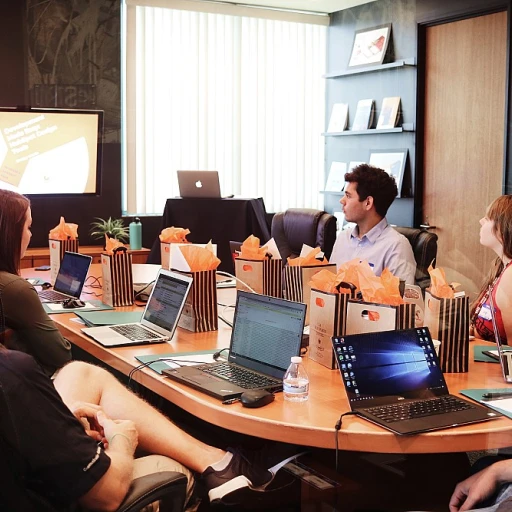
Understanding the Importance of Reskilling
Recognizing the Need for Skill Transformation
Understanding the importance of reskilling is crucial for businesses aiming to remain competitive and effectively training employees. With the rapid pace of technological advancements, job roles are continually evolving, necessitating a proactive approach to employee development. One of the primary objectives of a comprehensive training program is to enhance the skills and knowledge of the workforce, ensuring they can adapt to new challenges and fill specific job roles efficiently. This training process is not just about employee training in technical skills, but also involves understanding the broader goals and vision of the company. Employee training programs should be a cornerstone of a company’s development strategy, acting as a vital component in the onboarding process. Effective training can lead to higher retention rates and contribute to a robust company culture. By investing in training employees, organizations not only improve skills knowledge but also foster a supportive work environment conducive to continuous learning and growth. Moreover, comprehensive training programs that include orientation training, compliance training, and soft skills development can significantly enhance employee satisfaction and performance. Tailored training plans that align with the company’s objectives ensure that team members are equipped to meet the ever-changing demands of their roles. For more insights on the pivotal role of skill enhancement, read more about how a skills trainer contributes to reskilling initiatives. This ensures employees learn effectively, preparing them for leadership roles and fostering a sense of empowerment and accountability within the team.Creating Personalized Learning Paths
Tailored Training Strategies for Unique Needs
In the rapidly evolving landscape of work, it’s crucial for companies to implement effective training strategies that take into account the individual needs of their employees. Personalized learning paths are at the heart of this approach, allowing each employee to embark on a training journey that addresses their specific goals and skills requirements. This method recognizes that a one-size-fits-all training program may not effectively fill the diverse skills gaps within a team.
By focusing on personalized learning, companies can ensure that employees are not just passively absorbing information, but actively engaging with and integrating new knowledge into their work. This tailored approach aids in developing a robust set of skills and knowledge necessary for the job while aligning with the company’s overarching goals. Additionally, this focus nurtures a culture of continuous improvement and innovation, central to any robust training program.
To further enhance the effectiveness of a personalized training plan, it’s essential to understand the unique skills and competencies that will empower an employee to excel in their role. Successful companies often leverage a mix of technical training, team training, and development programs to equip employees with both job-specific and broad competencies. To maximize the benefits of these programs, employees should be actively involved in selecting their learning pathways in consultation with team leaders and training consultants.
Incorporating these holistic perspectives rewards companies with increased retention rates, as employees feel supported and valued in their development process. As a result, the onboarding process becomes not only a mechanism for compliance training but an integrated part of a long-term career development strategy that meets both employee aspirations and company objectives.
For those exploring the realm of personalized learning in reskilling efforts, seeking guidance from a learning and development consultant can provide invaluable insights. These consultants can offer expertise in crafting bespoke learning experiences that resonate with each employee's career trajectory and company culture, ensuring that both parties derive maximum benefit from the reskilling process.
Leveraging Technology in Training
The Power of Technology in Modern Employee Training
In today’s fast-paced work environment, harnessing the power of technology is crucial for effectively training employees during the reskilling process. Companies are increasingly adopting digital tools and platforms to make employee training programs more efficient and aligned with specific job roles.
Integrating e-learning platforms into your training plan allows employees to access resources at their own pace, which can significantly improve learning and retention rates. Providing a blend of instructional videos, interactive modules, and quizzes creates an engaging learning experience that aligns with the specific goals of the training program.
Moreover, training employees through virtual simulations and augmented reality can enhance technical training by providing realistic, immersive learning environments. Such technologies are particularly effective in teaching complex skills knowledge and can be a valuable addition to a comprehensive reskilling or onboarding process.
Collaboration tools and online forums are also vital as they foster team training and enable employees to work together, share knowledge, and solve problems collectively. This collaborative environment not only aids in skill development but also reinforces company culture and team cohesion.
Lastly, leveraging data analytics can be immensely beneficial to track the progress of the training process. By analyzing the performance metrics of team members in training programs, companies can fine-tune their strategies and ensure that the training aligns with the leadership and development needs of their workforce. This approach will effectively fill knowledge gaps and drive continuous learning and improvement within the team.
Incorporating Soft Skills into Reskilling Programs
Integrating Essential Soft Skills into Training Programs
In today's dynamic job market, the process of reskilling employees goes beyond simply updating technical knowledge or filling specific gaps in skills. It requires a comprehensive approach that considers the development of both technical and soft skills. The importance of soft skills cannot be overstated—they're crucial in fostering a productive and positive work environment, effectively training new hires, and ensuring the success of any reskilling program. Soft skills, such as communication, problem-solving, leadership, and team work, play a vital role in enhancing how employees learn and adapt to company culture. They help employees to effectively navigate challenges and collaborate seamlessly with team members. As organizations aim to boost retention rates, these skills become essential components of training programs. Here's why integrating soft skills into employee training initiatives matters:- Improved Communication: Training employees in effective communication enables them to articulate their ideas clearly, work collaboratively with team members, and contribute positively to leadership dynamics.
- Enhanced Problem-Solving Abilities: Programs focusing on developing problem-solving skills equip employees with the knowledge to tackle issues effectively and efficiently, ultimately benefiting the company’s goals.
- Leadership Development: Incorporating leadership training within reskilling initiatives prepares employees for future roles and helps to foster a culture of growth and advancement within the company.
- Facilitating Better Team Work: Soft skills training enhances team members’ ability to work collaboratively, ensuring that new hires effectively integrate into existing teams, which is crucial during the onboarding process.
The Role of Mentorship in Training New Hires
The Guiding Light for New Hires in a Reskilling Journey
Mentorship plays a fundamental role in effectively training employees, particularly when it comes to reskilling within a company. By having experienced team members step into mentorship roles, new hires can navigate their learning paths more smoothly, integrating both technical and soft skills in the process. This method not only enriches the company culture but also helps align the employees' development with the organization’s specific goals and objectives.
Mentors bring a wealth of skills knowledge that can help train employees by providing practical insights and real-world applications. As part of an overall training program, mentorship is indispensable. It bridges the gap between formal training and on-the-job experience, offering continuous support as new team members work through their reskilling program. Within a mentorship framework, new hires are better positioned to absorb both technical and compliance training, leading to higher retention rates and a smoother onboarding process.
Moreover, incorporating mentorship in reskilling creates an environment where employees learn from experiences rather than just instructions. By pairing them with mentors, it fosters the development of leadership qualities among both new employees and their mentors, as sharing knowledge and guiding others requires a nuanced understanding of the skills being taught. This not only supports the individual's growth but also enhances the team's cohesion and productivity.
Including mentors in the reskilling process facilitates a two-way learning street where new hires can gain insights into effective training techniques, while mentors can refine their own skills and approach towards instructional and motivational capabilities. As employees learn and adapt, the company as a whole stands to benefit from a workforce that's well-equipped to meet evolving business needs.
Continuous Feedback and Assessment
Emphasizing Ongoing Evaluation and Constructive Feedback
In the dynamic landscape of reskilling, the process doesn't simply end after initial training sessions. Instead, continuous feedback and assessment play pivotal roles in ensuring that new hires effectively absorb and apply their newly acquired skills. As such, companies should develop robust evaluation mechanisms within their training programs to gauge the efficacy of their initiatives. Firstly, it's crucial to establish clear objectives and specific goals from the outset of employee training. Defined outcomes enable organizations to measure progress accurately, helping both the company and the employees understand where improvements are needed.- Regular Assessments: Implement regular assessments to track the employee's progress across various stages of the training process. These assessments should cover both technical skills and soft skills to provide a holistic view of the employee's development.
- Constructive Feedback: Feedback should be constructive and continuous, allowing employees to understand their strengths and areas for improvement. Constructive criticism, coupled with reinforcement of their successes, aids in building confidence and knowledge retention.
- Feedback from Peers and Leadership: Encourage a culture where team members can provide input on each other's progress. Leadership should be involved in offering feedback, as it not only guides the learning journey but also underscores the company culture of open communication and support.
- Development Plans: Use feedback to craft tailored development plans that address individual needs and gaps. This personal approach ensures that employees learn at their own pace, aligning with the personalized learning paths discussed earlier.













